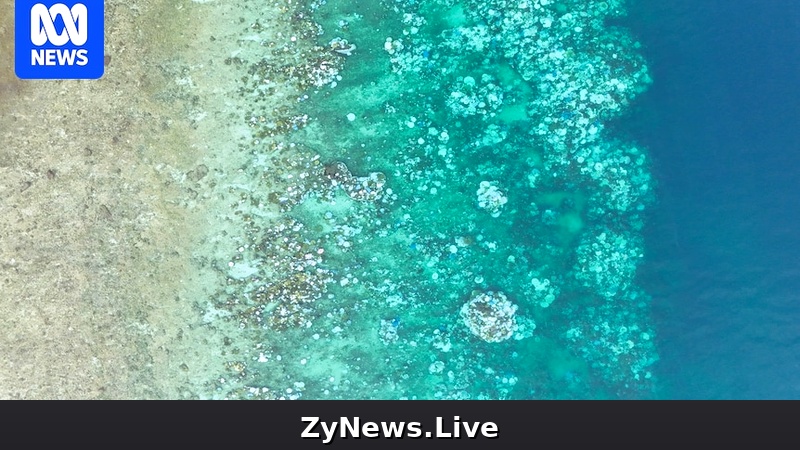'Our worst fears': Scientists warn of damage to Great Barrier Reef

# Parts of Great Barrier Reef record worst coral loss in 39 years, early AIMS survey results show
A section of bleached or dead coral reef near Lizard Island, in far north Queensland, in March. (Supplied: George Roff/CSIRO)
Large sections of the Great Barrier Reef appear to have been smashed by climate change and cyclones this year, with one reef near Lizard Island losing nearly three quarters of its coral cover since the beginning of the year.
Preliminary results from the Australian Institute of Marine Science (AIMS) annual survey show more than a third of coral cover was lost from surveyed reefs across the northern sections of the Great Barrier Reef, from the tourist mecca of Cairns up to Lizard Island.
Although the survey is only about 15 to 20 per cent complete, the northern reefs are so far revealing the biggest annual decline in coral cover in the 39 years AIMS has been conducting its Long Term Monitoring Program.
"These initial surveys from AIMS are our worst fears from this year's coral bleaching event being realised," said Richard Leck from WWF-Australia.
Reefs further south around Innisfail appeared to have been spared, with coral cover remaining roughly steady compared to pre-summer levels.
"These initial results show the vulnerability of the reef to bleaching events, which are increasing in frequency, footprint and intensity under climate change. Its resilience is being severely tested," said AIMS acting research director Dr Manuel Gonzalez Rivero.
## Scientists warn of repeated 'hammering' of the reef
The declines follow rapid recovery of fast-growing corals seen since the back-to-back mass bleaching events in 2016-2017.
Fast growing plate Acropora corals, sometimes informally referred to as "weedy" corals, can grow quickly after disturbances but are also very vulnerable to future events. They appear to have been most impacted in this survey.
"Other coral types, such as branching Acropora were less affected, while massive corals – like Porites — were least affected. This points to the variability and dynamics on coral reefs."
Scientists have warned that the repeated and worsening events damaging the reef are changing the coral mix to be dominated by these fast-growing but highly vulnerable species as big and resilient coral species don't have time to grow back when they are killed.
"The Great Barrier Reef can bounce back but there are limits to its resilience," Mr Leck said.
"It can't get repeatedly hammered like this. We are fast approaching a tipping point.
"We only need to look overseas to places like the Caribbean to know what happens if we cross that line."
## Bleaching, cyclones and climate change
Much of the coral destruction was caused by climate change-driven heat stress, which causes bleaching and death. When water temperatures are sustained above the tolerance of the coral, they lose their symbiotic algae that feeds them, and they starve and die.
"During February and March 2024, all the reefs we recently surveyed in this north Queensland region were subjected to levels of climate change-driven heat stress that cause bleaching. The heat stress got so high in some areas that mortality is not a surprising outcome," said Dr Mike Emslie from AIMS, who runs the Long-Term Monitoring Program.
A section of bleached or dead coral reef near Lizard Island in December 2023. (Supplied: George Roff/CSIRO)
A section of bleached or dead coral reef near Lizard Island in March 2024. (Supplied: George Roff/CSIRO)
And Australia is not the only country being hit by the destruction.
"The 2024 mass bleaching event on the reef, its fifth since 2016, forms part of the fourth global bleaching event impacting both the northern and southern hemispheres of the Atlantic, Pacific and Indian Oceans during 2023 and 2024, documented in more than 60 countries and territories worldwide," Dr Rivero said.
"Climate change is threatening reefs around the world. Their future relies on strong greenhouse gas emissions reduction, management of local and regional pressures, and the development of approaches to help reefs adapt to and recover from its impacts, which we are already seeing."
The results have renewed calls for Australia to implement more ambitious climate policies.
"Australia must commit to a federal emissions reduction target of at least 90 per cent below 2005 levels by 2035, stop approving new fossil fuel projects, and support the worldwide push for a global treaty to phase out all fossil fuels," Mr Leck said.
Two cyclones also contributed to damage across the northern sections, the report found.
"Cyclones Jasper and Kirrily also exposed many [areas] to wave heights likely to cause damage to corals, generally greater than four metres," Dr Emslie said.
The steady coral cover in the southern reefs in the survey was better news, highlighting how dependent the health of the reef has become on weather conditions.
The results are only preliminary, based on diving surveys between August and October this year.
"From what we have seen so far, the impact from these events is significant coral mortality in those areas hardest hit, although the level of mortality has been variable, and a few reefs escaped significant loss," Dr Emslie said.
The AIMS Long Term Monitoring Program usually monitors between 80 and 130 reefs across the Great Barrier Reef. The results so far are based on 20 reefs, with surveys continuing on the others.
"We still have a lot of reef to monitor and a full assessment of the impact on coral cover across the Marine Park will be available in mid-2025," Dr Emslie said.